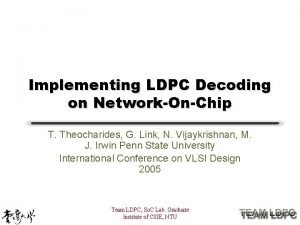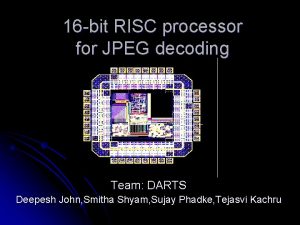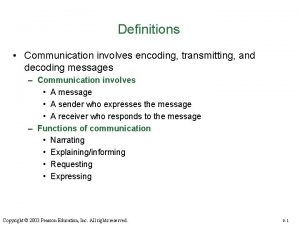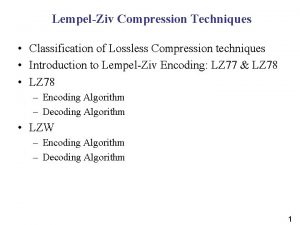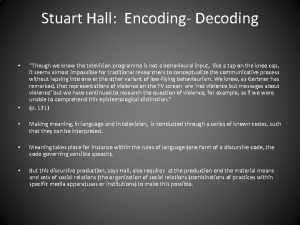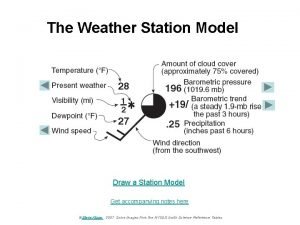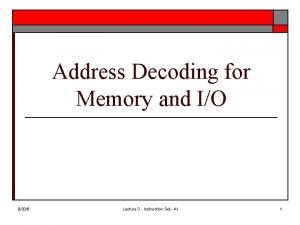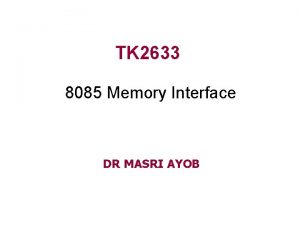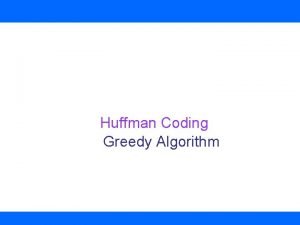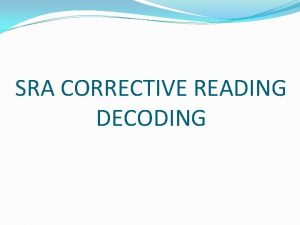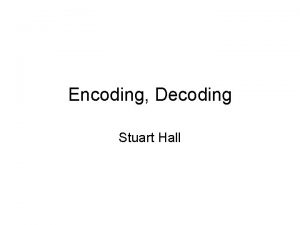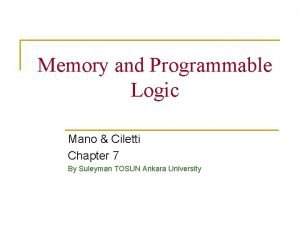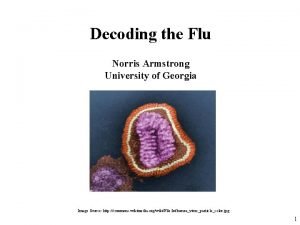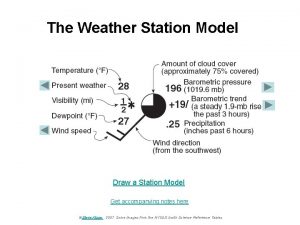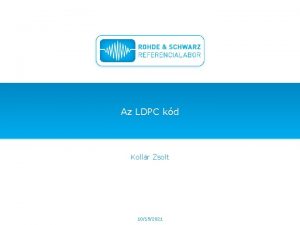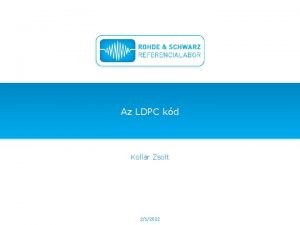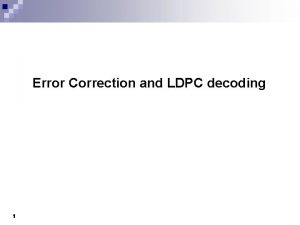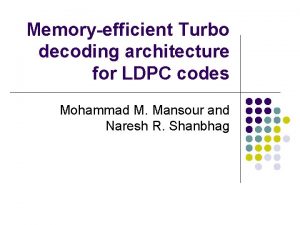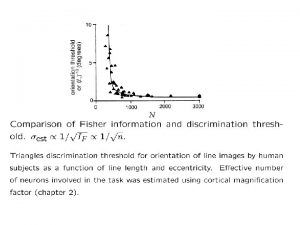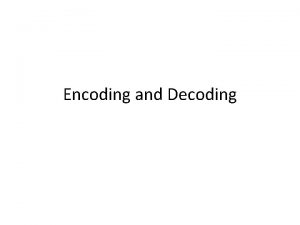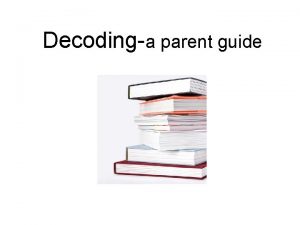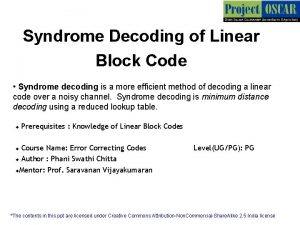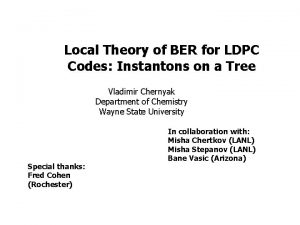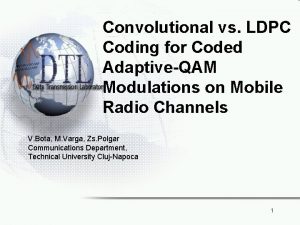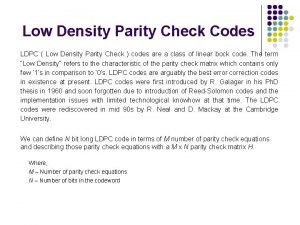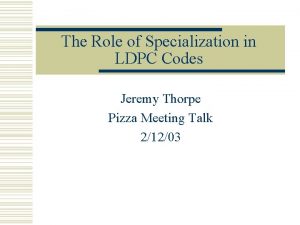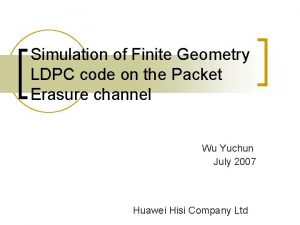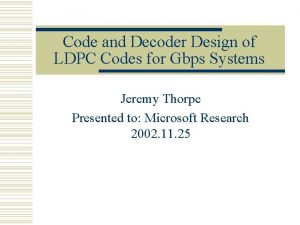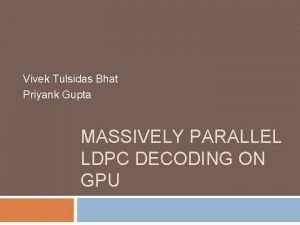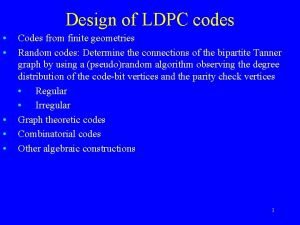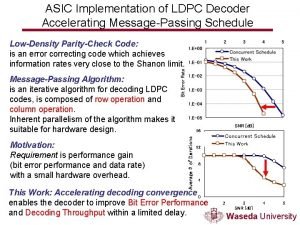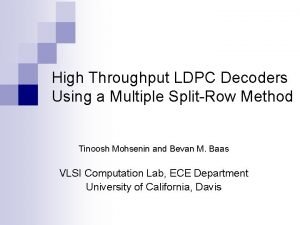Implementing LDPC Decoding on NetworkOnChip T Theocharides G

























- Slides: 25

Implementing LDPC Decoding on Network-On-Chip T. Theocharides, G. Link, N. Vijaykrishnan, M. J. Irwin Penn State University International Conference on VLSI Design 2005 Team LDPC, So. C Lab. Graduate Institute of CSIE, NTU

Outline • • • Intro Message Passing Iterative Decoding Word length Processing Elements Virtual & Physical nodes Network on Chip Packets Message Decoding Behavior Bit node PE & Check node PE Power Optimization Conclusion & Comparison Team LDPC, So. C Lab. Graduate Institute of CSIE, NTU

Intro • Addressing problem are either limited in the types of LDPC codes, or constrained by hardware. • Reconfigurable for different block sizes and code rates. Team LDPC, So. C Lab. Graduate Institute of CSIE, NTU

Message Passing • Start from bit function unit • Message passing iterations are performed by the two computation units. Team LDPC, So. C Lab. Graduate Institute of CSIE, NTU

Iterative Decoding • Check node operation where – This function is implemented by using a ROM based look-up table (LUT). Team LDPC, So. C Lab. Graduate Institute of CSIE, NTU

Iterative Decoding • Bit node operation • stored_llr describes the previously stored logarithmic likelihood ration for the bit. Team LDPC, So. C Lab. Graduate Institute of CSIE, NTU

Word length • Word length is critical parameter. – Performance – Power consumption • A large data word results in a lower BER even in noisy channels. – Sign-magnitude representation – 16 bit word length Team LDPC, So. C Lab. Graduate Institute of CSIE, NTU

Processing element (PE) • Bit and check nodes act as PEs. • PEs communicate via on-chip routers. • Each PE has a dedicated memory to store configuration information. Team LDPC, So. C Lab. Graduate Institute of CSIE, NTU

Virtual & Physical nodes • Virtual nodes cannot be mapped all at once on a single chip. a b c d e f VN A B PN Team LDPC, So. C Lab. Graduate Institute of CSIE, NTU C D E F G H I

Network on Chip (No. C) • Inter-PE communication is handled by an on-chip network consisting of a number of small on-chip routers. • A full packet of data moves one hop per clock cycle. • Losing a single packet is catastrophic to LDPC computation. Team LDPC, So. C Lab. Graduate Institute of CSIE, NTU

Packets • Physical destination address • Virtual identification information • Packet Mark (1 bit) Team LDPC, So. C Lab. Graduate Institute of CSIE, NTU

Packet Size • 48 bit for PN * 25, VN * 64, MAX=16 – Header 16 bit • • Physical address 5 bit Virtual address 6 bit Max 4 bit Reserved 1 bit – Data 16 bit * 2 • Word length 16 bit Team LDPC, So. C Lab. Graduate Institute of CSIE, NTU

Message Decoding Behavior • Analog signal arrives and is converted to llr values after ADC conversion, the llr values are grouped into message blocks. • Two blocks are decoded in parallel. (66% network traffic) Team LDPC, So. C Lab. Graduate Institute of CSIE, NTU

Bit Node PE • Node has 48 bit input, output ports. • Data concentrator directs values to accumulator base on VID. • Once all input values for a given virtual bit node are received, the computation proceeds to the execution unit. Team LDPC, So. C Lab. Graduate Institute of CSIE, NTU

Check Node PE • Node supports the simultaneous decoding of two independent message blocks. Team LDPC, So. C Lab. Graduate Institute of CSIE, NTU

Results • 16 physical bit nodes • 9 physical check nodes • 64 virtual nodes • 2 D Mesh topology Team LDPC, So. C Lab. Graduate Institute of CSIE, NTU

Power Consumption • 750 Mbps@500 MHz 34. 8 W (N=1024) – interconnect 43% – check nodes 23% – bit nodes 22% – leakage 12% Team LDPC, So. C Lab. Graduate Institute of CSIE, NTU

Power Consumption (detail) • A range between 25% and 40% of the total data passed between each node are either zero or infinity. (High switch activity) Team LDPC, So. C Lab. Graduate Institute of CSIE, NTU

Encoding Values • If the result is either zero or infinity, we set S 1 and S 2 to corresponding value. Team LDPC, So. C Lab. Graduate Institute of CSIE, NTU

Result • 750 Mbps@500 MHz (N=1024) – 34. 8 W 30. 36 W (-12. 75%) Team LDPC, So. C Lab. Graduate Institute of CSIE, NTU

Early Termination Team LDPC, So. C Lab. Graduate Institute of CSIE, NTU

Result (+Early Termination) • 750 Mbps@500 MHz (N=1024) – 34. 8 W 30. 36 W (-12. 75%) 24. 32 W (-30%) Team LDPC, So. C Lab. Graduate Institute of CSIE, NTU

Conclusion • Network-on-chip interconnect is scalable. • Multiple LDPC codes of varying types are supported. • Design can be extended into reconfigurable low-power decoders. Team LDPC, So. C Lab. Graduate Institute of CSIE, NTU

My conclusion • Distance between nodes must be considered. • Parameters (number of physical nodes, node placement) are the keys. • Two messages must have the same latency. • Syndrome test can offer early termination Team LDPC, So. C Lab. Graduate Institute of CSIE, NTU

Comparison This design Our design Number Representation Sign-magnitude 2’s complement & sign-magnitude Code type Arbitrary QC-LDPC Word Length 16 bit Data Overhead Packet header (48 bit) None Rate ¾ ½ ROM/LUT Required Not required HUE N/A >97. 56% (40 iter) Memory Req. Double size Single size Strategy Dual code simultaneous Single Algorithm SPA SMSA/SPA Addressing Router & HFT Counter Reconfigurable Feasible Team LDPC, So. C Lab. Graduate Institute of CSIE, NTU
 Path lab theocharides
Path lab theocharides 16 bit risc
16 bit risc Encoding definition in communication
Encoding definition in communication Fultonschools.og
Fultonschools.og Dystopia characteristics
Dystopia characteristics Decode
Decode Stuart hall encoding/decoding
Stuart hall encoding/decoding Draw a weather station model
Draw a weather station model Address decoding
Address decoding Decoding a flowers message
Decoding a flowers message Address decoding in 8085
Address decoding in 8085 Huffman coding using greedy algorithm
Huffman coding using greedy algorithm Coding io
Coding io Decoding skills
Decoding skills The sender of an integrated marketing communication
The sender of an integrated marketing communication Sra basic reading series
Sra basic reading series Decoding long words
Decoding long words Stuart hall encoding decoding
Stuart hall encoding decoding Coincident decoding
Coincident decoding Sender encoding message decoding receiver
Sender encoding message decoding receiver Decoding the flu case study answers
Decoding the flu case study answers Linguostylistics
Linguostylistics Meteorology station model
Meteorology station model Flanker brand strategy
Flanker brand strategy Qsen competencies teamwork and collaboration
Qsen competencies teamwork and collaboration Implementation of hrd program
Implementation of hrd program
